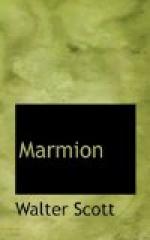’Besides these instances of Elfin chivalry above quoted, many others might be alleged in support of employing fairy machinery in this manner. The forest of Glenmore, in the North Highlands, is believed to be haunted by a spirit called Lham-dearg, in the array of an ancient warrior, having a bloody hand, from which he takes his name. He insists upon those with whom he meets doing battle with him; and the clergyman, who makes up an account of the district, extant in the Macfarlane Ms., in the Advocates’ Library, gravely assures us, that, in his time, Lham-dearg fought with three brothers whom he met in his walk, none of whom long survived the ghostly conflict. Barclay, in his “Euphormion,” gives a singular account of an officer who had ventured, with his servant, rather to intrude upon a haunted house, in a town in Flanders, than to put up with worse quarters elsewhere. After taking the usual precautions of providing fires, lights, and arms, they watched till midnight, when, behold! the severed arm of a man dropped from the ceiling; this was followed by the legs, the other arm, the trunk, and the head of the body, all separately. The members rolled together, united themselves in the presence of the astonished soldiers, and formed a gigantic warrior, who defied them both to combat. Their blows, although they penetrated the body, and amputated the limbs, of their strange antagonist, had, as the reader may easily believe, little effect on an enemy who possessed such powers of self-union; nor did his efforts make more effectual impression upon them. How the combat terminated I do not exactly remember, and have not the book by me; but I think the spirit made to the intruders on his mansion the usual proposal, that they should renounce their redemption; which being declined, he was obliged to retreat.




